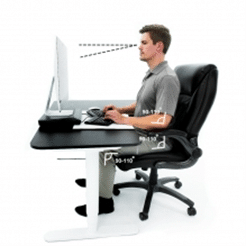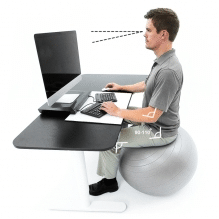Many of us have been working from home for more than a year due to the COVID-19 pandemic. Whether you will be home for a few more months, staying at home permanently, or going back to the office soon, it’s important to have a dedicated ergonomic workspace. A mediocre desk setup can lead to a multitude of health problems, including poor posture, stiffness, and neck or back pain. Establishing an ergonomic workspace can help prevent these types of problems from developing.
An ergonomic desk setup can be at a computer desk or at a table, as long as the area can be set up properly. First, choose a comfortable chair with lumbar support to promote an optimal upright sitting posture and to help avoid slouching. The chair height should allow for your knees to be bent at 90 to 110 degrees with your feet on the floor. Your arms should be relaxed at your sides with your elbows bent no more than 90 to 110 degrees to reach your keyboard. Lastly, the top of your screen should be level with your eyes, so you are looking down slightly to work on your computer screen.
Ideally, you should take a break every hour and stand up from your seated position. Whether it’s to take a bathroom break, grab a snack, or walk a few laps, these short breaks from sitting at your desk will help avoid stiffness throughout the day.
Ergonomic Desk Setup Alternatives
If you want to avoid sitting in a chair for long periods of time, there are some desk setup alternatives. Instead of a traditional chair, you can try a large exercise ball. Sitting on an exercise ball will challenge your core stability and trunk balance, which works your abdominal muscles and helps with back pain. The exercise ball should be large enough that you are able to sit with your hips and knees at 90 to 100 degrees and reach your keyboard with your arms at your side.
A standing desk is another alternative to a traditional desk and chair setup. It has been shown that people using standing desks burn more calories throughout the day, which could lead to a lower risk of obesity, diabetes, and cardiovascular disease. A standing desk does not have to be expensive and adjustable; you can make it out of a stack of books, a tall box, or standing at a tall counter. For the best standing position, the desk height should be tall enough that you are not hunching over to see your computer screen and you can reach your keyboard with your arms by your side. It may take time to get used to standing all day; you could try switching between a chair and using a standing desk throughout the day to give yourself breaks from sitting and build up the stamina to stand.
If you can, invest in a proper desk setup; after all, most of us spend the majority of our day at our desk. Even small changes to your working space can help improve your overall health.








